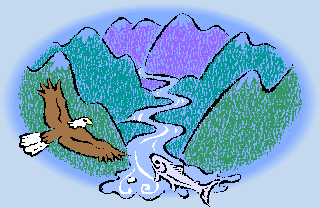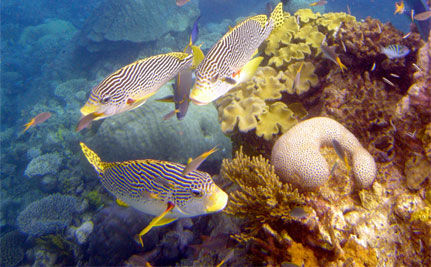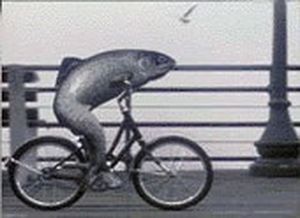
An Email Publication About Water and Water Treatment
January 2011
 |
An Email Publication About Water and Water Treatment January 2011 |
In this first Occasional for 2011, you'll hear about floods in Australia, mass graves of dead pigs in South Korea, and a famous Canadian Groundhog named Wharton Willie. Learn about tungsten as a water contaminant, no-water urinals, the "water case of the century," and threats to the Great Barrier Reef. Read Pure Water Annie's advice on whole house filter sizing and B. Bea Sharper's interesting figures on anti-depressant use in Montreal. Learn how floods cause water shortages and why fish are better than bicycles and vice versa. News about the mysterious deaths of trees in North Carolina and of birds and fish in Arkansas. Read the astounding news of the very first ever world map of fluid flow ease and the government's lowering of its fluoride dosage recommendations. Hear about the surprising sodium content of bouillon cubes, the latest doings of oil-eating bacteria, the shoddy horse manure disposal habits of a famous race track, the appearance of new, scary amoebas, and, as always, much, much more. The Occasional is overseen by Pure Water Gazette editor Hardly Waite. |
 |
Water News for January 2011While you were planning your Groundhog Day festivities, a lot of important things happened in the world of water. Read on to find out more.
|
 |
| As the result of flooding in Australia, plumes of dirty, fresh water from the Burdekin, Fitzroy and Burnett rivers are flowing into the ocean and creating a significant threat to the Great Barrier Reef. |
China plans to spend over $300 billion for improvement of rural drinking water systems over the next five years.
Residents in a small community in Nueces County, TX are receiving water that exceeds federal arsenic standards. See pictures of a backyard water plant typical of those that serve some small communities.
The mass burial (often alive) of 1.4 million diseased pigs and cows in South Korea has raised grave concerns about drinking water contamination. Blood was found in the drinking water of one village.
University of British Columbia researchers have produced the first map of the world outlining the ease of fluid flow through the planet's porous surface rocks and sediments.
Genetically-modified (GM), oil-eating bacteria introduced into the Gulf as part of the oil disaster's remediation efforts are reportedly causing the emergence of various other mutant bacteria, as well as increasingly severe harm to humans and the environment.
Norman OK has put together a team of experts to study the presence of hexavalent Chromium (see last month's Occasional for details).
Too much water is causing water shortages in Australia.
The Wishing Well Foundation, a water charity, launched a new website.
Harrah's Casino and Racetrack has agreed to pay a $39,000 penalty for offenses related to the EPA discovery of horse manure in areas that threaten the Delaware River.
The city of Jacksonville NC is investigating the mysterious deaths of many trees in a forest near its waste water treatment plant.
Tungsten, which has previously been viewed as an inert metal of no consequence in drinking water, is being studied at Kansas State University as a toxic substance and a possible cause of childhood leukemia and other cancers. Tungsten is a naturally occurring metallic element that in its alloy or solid form is primarily used for incandescent lightbulb filaments and X-ray tubes."In an effort to limit toxins in the environment, tungsten is replacing lead in fishing weights and in ammunition for hunting and recreational shooting. The military is substituting tungsten in its high kinetic energy penetrators and small arms ammunition, as well as other ammunitions."
According to Science News, "Amoebas — blob-shaped microbes linked to several deadly diseases — contaminate drinking-water systems around the world, according to a new analysis. The study finds that amoebas are appearing often enough in water supplies and even in treated tap water to be considered a potential health risk." See the article for scary pictures.
According to the Guardian and the BBC, about half of the fish caught in the North Sea, a prime deep sea fishing area, are thrown back into the water, either because they do not meet the quotas set by Europe's common fisheries policy, or because the supermarkets don't want to buy them. Virtually all of these fish die. (Article with video.)
As water becomes scarce, rainwater collection systems are becoming increasingly popular.
After water is collected and stored for later use, water treatment is essential. This usually takes the form of filtering out large particles then treating for microbiological safety. If the water is contaminated with chemicals from its collection process (for example, roofing materials if the water is collected from a roof), then a good carbon filter should be added to the treatment.
Filtering for sediment can be either with cartridge filters or, if there is a lot to be filtered out, a backwashing filter that filters down to 10 microns or so.
It is critical that some form of disinfection be used. This can be:
Chlorination, the old standby, followed by carbon filtration to remove the chlorine.
Ultraviolet (UV), which is probably the most popular single rainwater treatment. The water must be very clean when it passes the UV lamp to assure complete disinfection. UV has the advantage of adding no chemicals to the water. It should be the last stage in the treatment process.
Ozonation is an excellent disinfectant, but is a bit more challenging from the technical viewpoint.
Ultrafiltration (UF) is gaining popularity in rainwater treatment. UF filters down to about 0.02 microns—enough to remove cysts, bacteria and viruses. Again, water must be pre-filtered before the UF membrane to protect it from premature clogging.
Rainwater, with only the minimal treatment described above, can provide extremely good water. Its mineral content (TDS: Total Dissolved Solids) is very similar to that of reverse osmosis water.
As far as I know, there's no law against making outrageously stupid statements, although there probably should be if only to protect advertisers from making fools of themselves.
There are certain water treatment myths and exaggerations that have been repeated so many times that people who say them actually believe them. Like, "Reverse osmosis does not remove chlorine," or "Carbon filters don't remove chloramines."
Here's a clip from a website touting a drinking water filter that contains the popular and very useful filter medium KDF55. The ad is in bold type and my comments are in italics.
Independent laboratory tests confirm that KDF®55 is one of the best media for improving drinking and bathing water naturally and economically. That is why we incorporate it into our technology.
Compared to carbon-only units, KDF®55 lasts far longer, doesn't’t permit bacterial growth, and removes a much wider range of inorganic matter (e.g. heavy metals).
While this is all true to a degree, you could also say:Compared with carbon filters, KDF55 does not improve taste and odor appreciably,does not treat most organic chemicals, does not work well at all if not accompanied by carbon, does not treat VOCs, does not remove chloramines, etc. for pages and pages.
Compared to reverse osmosis, KDF®55 is less expensive, wastes no water, does not require membrane replacement, works at most water temperatures and pressures, and removes chlorine.
Compared with reverse osmosis, KDF does not remove fluoride, does not remove nitrates, does not reduce dissolved solids, does not remove sodium, does not remove chlorides, cannot desalinate sea water, does not remove hardness, etc., etc. for about forty pages.
Compared to ultraviolet lights, KDF®55 works in cloudy water, doesn’t require bulb replacement or electricity, and removes inorganics.
Compared with ultraviolet light, KDF does not keep water safe from e. Coli, does not kill viruses, does not kill cryptosporidium or Guardia, etc. etc. for many pages.
Compared to ozone, KDF®55 provides a residual effect to keep bacteria from growing in water, does not require electricity, and costs far less to buy and maintain.
Compared with ozone, KDF does not oxidize significant amounts of iron or hydrogen sulfide, does not make non-potable water safe for drinking, does not act as a disinfectant, etc.
 |
Fish are superior to bicycles because you don't have to oil their chain. |
KDF 55 is very good stuff. We use it a lot in carbon/KDF filters, and it's the main ingredient in most shower filters sold today. But to try to compare a KDF filter to a reverse osmosis unit is like the proverbial comparison of a fish to a bicycle. Compared to a fish, a bicycle cannot swim into deep river channels, has to have air in its tires, and is difficult to peddle uphill. That's fine, but does it really prove that fish are superior to bicycles? It isn't any sillier than the attempt to compare KDF, a granular filter medium made of copper and zinc, to ultraviolet light. Doesn't require bulb replacement, indeed!
David M. Bauman, CWS-VI, CI, CCO, is technical editor of Water Technology®and a water treatment consultant in Manitowoc, WI. He writes a regular column called “Professor POU/POE,” that appears in each issue of Water Technology--both print and online versions. Water Technology is a leading trade journal read by water treatment professionals. It is online at www.watertechonline.com. The information below is adapted from a recent article.
The "Professor" here address a frequently voiced concern about the amount of sodium that water softeners add to drinking water.
First keep in mind that there is already sodium in the untreated water. This cannot be avoided, so potential softener owners will have sodium in their water with or without softening.
Then the question is how much sodium will be added by softening the water. Frequently, the sodium added is much less than that which is in the raw water.
My favorite way to respond to this is to calculate the amount of sodium added by softening then compare it to the existing sodium and/or to the sodium in some common foods or beverages.
Since hardness is exchanged for sodium, start with the amount of hardness, and then convert it to the equivalent amount of sodium:
• GPG (grains per gallon) total hardness as CaCO3 (calcium carbonate … total hardness is always expressed as its calcium carbonate equivalent) is exchanged for an equal value of sodium as CaCO3. So, if the hardness is 20 gpg as CaCO3, the sodium added is 20 gpg as CaCO3.
• Then, multiply gpg Na (sodium) as CaCO3 x .460 (to convert Na as CaCO3 to Na as Na). 20 gpg Na as CaCO33 becomes 20 x 0.460 or 9.2 gpg Na as Na.
• To compare with the common way of expressing sodium, convert Na in gpg to Na in mg/L (milligrams per liter, same as ppm). Multiply 20 gpg Na times 17.1 to determine that there will be 157 mg/L (ppm) Na added during softening.
• To phrase this as a common volume of water multiply 157 x 0.24 to get 38 mg of sodium in 8 oz. of treated water.
• The above steps were given for educational purposes. A short-cut would be to multiply the total hardness of 20 gpg x 1.89 to get the same 38 mg per 8 oz. glass of softened water.
To compare this to common sodium levels in foods and beverages, I refer to the WQA technical paper titled “Sources of sodium in the diet.” This reveals that a slice of white bread contains 161 mg, a tablespoon of ketchup contains 204 mg and a can of Pepsi-Cola contains 38-49 mg of sodium. Given these levels, the amount of sodium added by softening seems quite inconsequential.
(See B. Bea Sharper's article below for more sodium content figures for common foods.)
Note from the Occasional: I don't want to muddy the softened waters, but you should note that there is some slight of hand taking place, The 1.89 times grains per gallon of hardness is yielding not mg per liter, the usual measurement of water constituents, but mg per 8 oz., a common water serving size. Therefore, the softener isn't adding 1.89 mg of sodium for each grain of hardness it removes, but about four times that amount. A better multiplier would be 7.5 mg/L sodium added for each grain of hardness removed.
Here's a clip from a nutrition website on the same subject:
For most individuals, the amount of sodium present in softened water is not a health problem. If however, you are trying to maintain a low sodium diet, this can add to your difficulties.
The amount of sodium in softened water can vary. According to a paper by Yarows et al., (Sodium concentration from water softeners, Arch Intern Med. 1997 Jan 27;157(2):218-22) the sodium concentration of softened well water averaged 278 mg/L but the variation was very large. Levels from 46 to 1219 mg/L were observed. 17% of households had sodium levels above 400 mg/L. The amount of sodium that gets added depends on how hard the water is to start with. If the water is very hard then the sodium level will be higher, as shown in the table below.
Initial Hardness |
Na added |
| 10 | 75 |
| 20 | 150 |
| 30 | 225 |
Actually, the nutrition website's figures and Professor POU's are identical. They are just stated differently. Multiply the grains of hardness by 7.5, not 1.89, to get an accurate estimate to the sodium added by softening.
If sodium is a concern, an undersink reverse osmosis unit will remove virtually all of the natural sodium in tap water as well as the sodium added by the softener. Softeners and reverse osmosis units are perfect companions, since the RO unit removes the sodium added by the softener, and the RO unit thrives on the softened water. Sodium (as opposed to the calcium removed by the softener) is very easy on the RO membrane. RO membrane life is greatly extended when it processes either naturally soft or softened water.
How to decide what size whole house filter you need.by Pure Water AnnieMore good advice from the Occasional's Technical Department.
One of the critical factors in determining the size of a "whole house" water treatment system, whether you're removing iron from well water or chemicals from city water, is the rate of service flow you need. To work effectively, the filter must be large enough to handle the volume of water, in gallons per minute, that you plan to run through it. Here's a chart that will help you take an educated guess at how much water you would expect to use. The numbers are based on Annie's years of experience in water treatment and some clever theft from other sources.
Too Much Fluoride
|
 |
Pure Water Gazette numerical wizard B. Bea Sharper reports the water facts that Harper's misses. |
Percentage of US adolescents who have tooth streaking or spottiness because of too much fluoride, according to a recent government study: 40%.
Number of football fields that could be covered with the surface area within a single pound of granular activated carbon (GAC): 75 to 130.
Amount of sodium added to an 8 oz. glass of water by a water softener processing 7 grain hard water: 13 mg.
Amount of sodium in an 8 oz. glass of 7 grain hard water after it has been processed through a water softener then an undersink reverse osmosis unit: 0.6 mg.
Amount of sodium in a slice of white bread: 161 mg.
Government recommended level of fluoride in drinking water under the new Dept. Of Health and Human Services standard: 0.7 mg/L.
Expected cost of chemical cleanup of an abandoned Hillsborough, N.H. flea market: $763,000.
Typical sodium removal percentage by a reverse osmosis unit: 96%.
Typical sodium removal percentage by a KDF-based water filter: 0%.
Mg/l of sodium you would add to your water if you softened your 10-grain-per-gallon hardness tap water: 75.
Percentage of Montreal residents who take antidepressants (which eventually end up in the city's wastewater system): 25%.
Number of children who die each year from waterborne disease: 1.6 million.
Milligrams of sodium in a 100 gram serving of raw apple: 1.
Milligrams of sodium in a 100 gram serving of cooked broccoli: 10.
Milligrams of sodium in a 100 gram serving of bouillon cubes: 24,000
Milligrams of sodium in a 100 gram serving of commercial cereals : 700 to 1100.
Number to multiply the grains per gallon hardness of your water by to determine how many mg/L of sodium would be added by a water softener: 7.5 .
Suggested reading this month from the Pure Water Gazette's archive: "Excrement Happens." Everything you might want to know about management of human waste. Reprinted from the now defunct Rachel's Environmental Newsletter. There's more to know about this than you would imagine.
Model 77: "The World's Greatest $77 Water Filter"
Sprite Shower Filters: You'll Sing Better!
An Alphabetical Index to Water Treatment Products
Occasional's Fair Use Statement
Please Visit